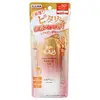What's inside
What's inside
 Key Ingredients
Key Ingredients

 Benefits
Benefits

 Concerns
Concerns

 Ingredients Side-by-side
Ingredients Side-by-side

Cyclopentasiloxane
EmollientWater
Skin ConditioningZinc Oxide
Cosmetic ColorantEthylhexyl Methoxycinnamate
UV AbsorberTriethylhexanoin
MaskingAlcohol
AntimicrobialSynthetic Fluorphlogopite
Glycerin
HumectantMethyl Methacrylate Crosspolymer
Lauryl PEG-9 Polydimethylsiloxyethyl Dimethicone
Skin ConditioningHydrated Silica
AbrasiveDiethylamino Hydroxybenzoyl Hexyl Benzoate
UV FilterSodium Hyaluronate
HumectantTocopheryl Acetate
AntioxidantMagnesium Ascorbyl Phosphate
AntioxidantDipotassium Glycyrrhizate
HumectantAcrylates/Dimethicone Copolymer
Skin ConditioningHydrogen Dimethicone
Titanium Dioxide
Cosmetic ColorantPolyglyceryl-2 Triisostearate
EmulsifyingMica
Cosmetic ColorantMethylparaben
PreservativePanthenol
Skin ConditioningSilica
AbrasiveDimethicone
EmollientVinyl Dimethicone/Lauryl Dimethicone Crosspolymer
Disodium EDTA
Triethoxycaprylylsilane
Ultramarines
Cyclopentasiloxane, Water, Zinc Oxide, Ethylhexyl Methoxycinnamate, Triethylhexanoin, Alcohol, Synthetic Fluorphlogopite, Glycerin, Methyl Methacrylate Crosspolymer, Lauryl PEG-9 Polydimethylsiloxyethyl Dimethicone, Hydrated Silica, Diethylamino Hydroxybenzoyl Hexyl Benzoate, Sodium Hyaluronate, Tocopheryl Acetate, Magnesium Ascorbyl Phosphate, Dipotassium Glycyrrhizate, Acrylates/Dimethicone Copolymer, Hydrogen Dimethicone, Titanium Dioxide, Polyglyceryl-2 Triisostearate, Mica, Methylparaben, Panthenol, Silica, Dimethicone, Vinyl Dimethicone/Lauryl Dimethicone Crosspolymer, Disodium EDTA, Triethoxycaprylylsilane, Ultramarines
Water
Skin ConditioningAlcohol Denat.
AntimicrobialEthylhexyl Methoxycinnamate
UV AbsorberButylene Glycol
HumectantIsononyl Isononanoate
EmollientGlycerin
HumectantDiethylamino Hydroxybenzoyl Hexyl Benzoate
UV FilterDiethylhexyl Succinate
EmollientBis-Ethylhexyloxyphenol Methoxyphenyl Triazine
Skin ConditioningLoess Extract
Skin ConditioningSodium Hyaluronate
HumectantSilica
AbrasiveEthylhexyl Triazone
UV AbsorberPolyglyceryl-10 Pentaisostearate
EmollientHydrogenated Polyisobutene
EmollientAcrylates/C10-30 Alkyl Acrylate Crosspolymer
Emulsion StabilisingMyristyl Myristate
EmollientMelaleuca Alternifolia Leaf Oil
AntioxidantFructose
HumectantDiethoxyethyl Succinate
SolventDisodium EDTA
Xanthan Gum
EmulsifyingPhenoxyethanol
PreservativeBiosaccharide Gum-4
Skin ConditioningWater, Alcohol Denat., Ethylhexyl Methoxycinnamate, Butylene Glycol, Isononyl Isononanoate, Glycerin, Diethylamino Hydroxybenzoyl Hexyl Benzoate, Diethylhexyl Succinate, Bis-Ethylhexyloxyphenol Methoxyphenyl Triazine, Loess Extract, Sodium Hyaluronate, Silica, Ethylhexyl Triazone, Polyglyceryl-10 Pentaisostearate, Hydrogenated Polyisobutene, Acrylates/C10-30 Alkyl Acrylate Crosspolymer, Myristyl Myristate, Melaleuca Alternifolia Leaf Oil, Fructose, Diethoxyethyl Succinate, Disodium EDTA, Xanthan Gum, Phenoxyethanol, Biosaccharide Gum-4
 Reviews
Reviews

Ingredients Explained
These ingredients are found in both products.
Ingredients higher up in an ingredient list are typically present in a larger amount.
Diethylamino Hydroxybenzoyl Hexyl Benzoate (DHHB) is a chemical UV-A absorber. It is formulated for high UVA protection (320-400 nm).
DHHB is well-liked for:
DHHB has been approved by the EU, Japan, Taiwan, and South America for use up to 10%. Unfortunately, it has not been approved for use in the US or Canada due to slow regulatory processes.
This ingredient is soluble in oils, fats, and lipids.
Learn more about Diethylamino Hydroxybenzoyl Hexyl BenzoateDisodium EDTA plays a role in making products more stable by aiding other preservatives.
It is a chelating agent, meaning it neutralizes metal ions that may be found in a product.
Disodium EDTA is a salt of edetic acid and is found to be safe in cosmetic ingredients.
Learn more about Disodium EDTAEthylhexyl Methoxycinnamate is an organic compound that provides UVB protection. It often goes by the more common name of octinoxate. It is created from methoxycinnamic acid and 2-ethylhexanol.
Ethylhexyl Methoxycinnamate absorbs UVB rays with wavelengths between 280-320 nm. UV absorbers protect your skin by using chemical reactions to convert UV rays into heat and energy.
UVB (290-320 nm) rays emit more energy than UVA rays. They are capable of damaging DNA, causing sunburns and are thought to be linked to skin cancer.
The state of Hawaii has banned sunscreens containing octinoxate due to its potential impact on coral reefs. More research is needed to bridge gaps in this research. The European Union allows higher levels of octinoxate in sunscreens than the US and Australia.
Ethylhexyl Methoxycinnamate is oil soluble. It is not stable and may lose efficacy when exposed to sunlight.
Learn more about Ethylhexyl MethoxycinnamateGlycerin is already naturally found in your skin. It helps moisturize and protect your skin.
A study from 2016 found glycerin to be more effective as a humectant than AHAs and hyaluronic acid.
As a humectant, it helps the skin stay hydrated by pulling moisture to your skin. The low molecular weight of glycerin allows it to pull moisture into the deeper layers of your skin.
Hydrated skin improves your skin barrier; Your skin barrier helps protect against irritants and bacteria.
Glycerin has also been found to have antimicrobial and antiviral properties. Due to these properties, glycerin is often used in wound and burn treatments.
In cosmetics, glycerin is usually derived from plants such as soybean or palm. However, it can also be sourced from animals, such as tallow or animal fat.
This ingredient is organic, colorless, odorless, and non-toxic.
Glycerin is the name for this ingredient in American English. British English uses Glycerol/Glycerine.
Learn more about GlycerinSilica, also known as silicon dioxide, is a naturally occurring mineral. It is used as a fine, spherical, and porous powder in cosmetics.
Though it has exfoliant properties, the function of silica varies depending on the product.
The unique structure of silica enhances the spreadability and adds smoothness, making it a great texture enhancer.
It is also used as an active carrier, emulsifier, and mattifier due to its ability to absorb excess oil.
In some products, tiny microneedles called spicules are made from silica or hydrolyzed sponge. When you rub them in, they lightly polish away dead skin layers and enhance the penetration of active ingredients.
Learn more about SilicaSodium Hyaluronate is hyaluronic acid's salt form. It is commonly derived from the sodium salt of hyaluronic acid.
Like hyaluronic acid, it is great at holding water and acts as a humectant. This makes it a great skin hydrating ingredient.
Sodium Hyaluronate is naturally occurring in our bodies and is mostly found in eye fluid and joints.
These are some other common types of Hyaluronic Acid:
Learn more about Sodium HyaluronateWater. It's the most common cosmetic ingredient of all. You'll usually see it at the top of ingredient lists, meaning that it makes up the largest part of the product.
So why is it so popular? Water most often acts as a solvent - this means that it helps dissolve other ingredients into the formulation.
You'll also recognize water as that liquid we all need to stay alive. If you see this, drink a glass of water. Stay hydrated!
Learn more about Water